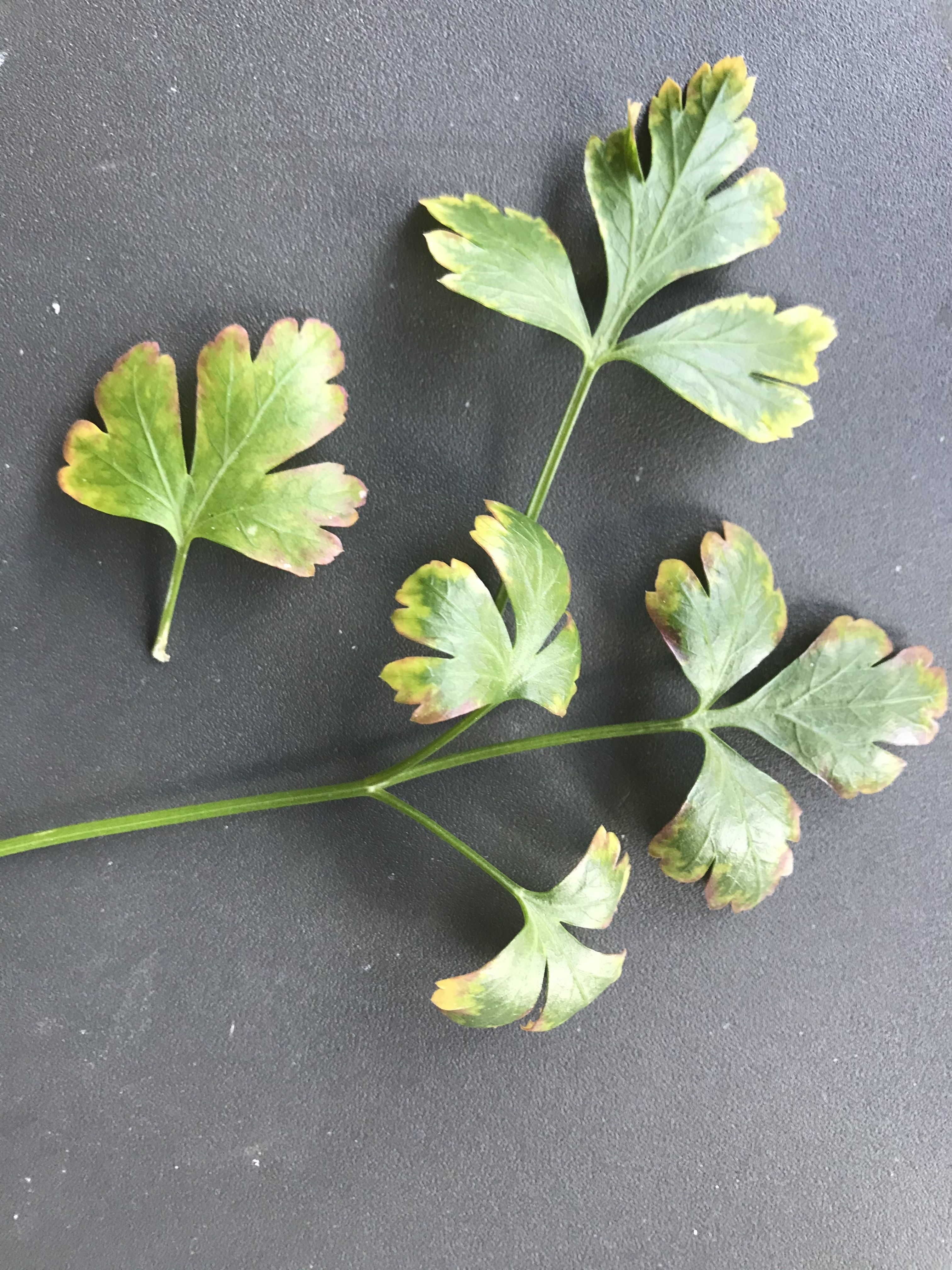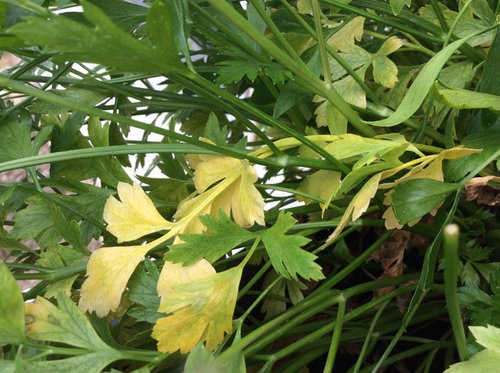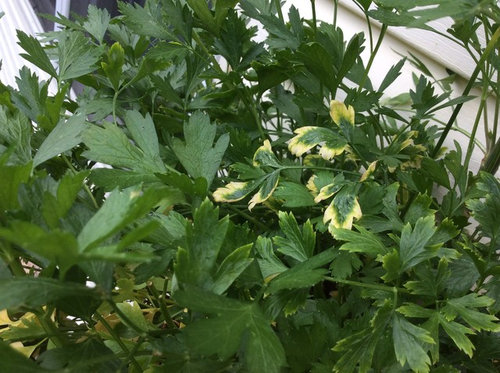However, parsley leaves can also become yellow as a result of aphid or spider mite infection. Parsley leaves can turn yellow as a result of root rot or crown rot induced by saturated soil, or as an indication of stress owing to a lack of water.
Saving parsley from turning yellow owing to aphids, spider mites, and dryness is reasonably simple to do, but prevention and best practices of care are better than cure in the case of parsley leaves turning yellow due to root rot or crown rot.
Read on to find out how to fix each issue that leads to parsley leaves turning and keep your herbs alive!
Table of Contents
Parsley Turning Yellow: Root Rot and Fungal Disease
- Symptoms. With drooping or wilting stems, parsley leaves turn brown or yellow.
- Causes. underwatering, slow-draining soils, or pots with inadequate drainage.
The most frequent causes of parsley becoming yellow include too much watering, soggy ground, or planting it in a pot without drainage holes in the base.
The ideal soil for growing parsley is one that is moist, rich in organic content, and well-draining.
A higher danger of fungal diseases like root rot and crown rot, which both cause the leaves of parsley to turn yellow and the stems to sag downward, exists in saturated or soggy soil as opposed to plain moist soil.
How to Save Yellow Parsley In Saturated Soil
- Restrict the irrigation.
- By transplanting to a pot or container, the drainage will be improved.
- Make sure the parsley is in a container with drainage holes at the bottom (avoid using a saucer or drip tray underneath the pot).
Reduce watering as soon as you notice yellowing in your parsley.
Although the roots of parsley do not like to be left in still water, the soil must be evenly moist.
However, rather than just overwatering, the real cause of yellow leaves is either slow draining soils or pots with poor drainage.
When preparing the soil or potting mix for parsley planting, high-quality compost must be used.
Compost aids in moisture retention, but it also includes pores that enable extra water to drain away from the roots, giving parsley the ideal moisture balance and assisting in the prevention of fugal disease.
In order to help with drainage, it is preferable to move parsley that has been planted in soggy or slow-draining soil (like clay) into a pot, container, or raised bed.
Parsley grows better in pots and has yellower leaves because:
- Compared to garden soil, the drainage characteristics in pots are naturally better.
- It is far simpler to construct a potting mix for parsley than it is to modify garden soil to make it more conducive to parsley growth.
To prevent the spread of any fungal diseases, use sterile pruners to cut back any yellow foliage as close to the ground as you can. Instead of adding the yellow leaves to a compost pile, dump them in a bin or burn them.
Although it might be simpler to purchase some more parsley plugs or seeds and grow it again with better drainage conditions, parsley can be recovered by planting it in pots and containers with a few drainage holes in the base and making sure your compost is well draining.
Drought Causes Parsley to turn yellow
Yellow parsley is caused by underwatering if:
- From the bottom up, the leaves are turning yellow.
- Stems have a withered appearance and are drooping.
- To a depth of two fingers, the earth seems somewhat dry.
In soil or compost that is rich in organic matter and retains moisture while having a porous structure that allows extra water to drain away, parsley thrives.
The soil may dry out too quickly for the roots to pull up the water the plant needs and the leaves may turn yellow as a sign of stress if it is too stony or sandy and lacks any significant organic matter.
Planting parsley in inadequately sized pots or containers is an additional, possibly more prevalent issue than inadequate watering and sandy soils.
In direct sunlight, smaller pots and containers heat up and dry out more quickly, which naturally causes dry soil and parsley that is dehydrated.
How to Save Yellow Parsley due to Drought
Make sure the soil is continually moist if you want to revive yellow parsley in dry soil.
Watering: Generally speaking, providing parsley with water once every three days is adequate to maintain a healthy plant.
To keep the parsley from drying out, you should modify the frequency of your watering to maintain the ideal balance of moisture in your climate.
Parsley in a pot may need daily watering during the height of summer during a drought to stay healthy.
Compost: To prevent the soil from drying up too quickly, plant parsley in rich compost (multipurpose compost from the garden center is ideal). Combine this with a regular watering schedule.
Compost, leaf mold, or well-rotted manure are examples of mulches that can assist keep moisture in the soil while planting parsley in the ground or in raised beds.
Pots and other containers: A larger pot has a greater capacity for soil and can hold moisture for a longer period of time.
Too-small potted parsley frequently wilts and turns yellow as a symptom of stress.
In order to protect my parsley plants from drought during the sweltering summer months and to make sure they have enough soil to get the nutrients they need, I plant them in pots that are at least 12 inches across.
Metal or plastic pots and containers should be handled with caution since they conduct heat more easily than clay or ceramic pots.
The evaporation from the soil increases if the pots heat up too much in the sun, which might turn the parsley yellow.
Your yellow parsley can begin to recover from dehydration during the following few days if you plant it in a good-sized pot or container with plenty of compost and consistent watering.
Aphids and Spider Mites
In most gardens, aphids, which are tiny, green insects that harm a wide range of plants, are controlled by predatory insects.
Aphid infestation in your parsley can cause yellowing of the leaves and crooked growth.
Aphids rarely cause serious issues and rarely cause harm that is considerable.
addressed, and they are simple to take off by hand.
If I have a lot of parsley growing, I normally remove the aphid-infested stems and leaves and keep an eye on the plant to make sure there are no new infestations.
Yellow patches result from spider mites:
If your parsley’s leaves have a few tiny yellow spots on them, spider mites are to blame.
Spider mites are so tiny that they are hardly noticeable, but the yellow spots or stipples that they generate on your parsley leaves can be an issue.
The parsley may wilt or develop in a stunted manner if a severe spider mite infestation is not handled.
Spider mites typically target plants that are ill because of a lack of water, poor soil nutrition, excessive fertilizer, or insufficient sunlight.
To maintain the parsley healthy and increase its resistance to illnesses and spider mites, plant it in full sun to partial shade with good compost.
Trim away any damaged foliage, and only if required, spray the leaves with an organic insecticidal soap in the morning.
Lack of Sun and Poor Soil
Too much shade or nutrient-deficient soil are two more potential (and easily remedied) issues that could result in yellow parsley.
Sunlight: Parsley grows well in both full sun and partial shade.
Parsley grows best in full sun in cooler temperate settings, whereas it prefers partial shade in hotter climates so it can escape the harsh heat and the shadow can reduce soil evaporation (6 hours of sun per day).
The growth of the parsley will be slow, the stems may droop, and parts of the leaves may turn yellow if it is overly shadowed.
It is good to grow parsley in pots because you can move them around to find the best combination of sun and shade for growing parsley in your climate and preventing the plant from turning yellow.
If your parsley is overly shaded, move it to a more sunny spot and cut down any badly yellowed leaf, and the parsley should recover.
Poor Soil: Parsley prefers rich soil that is rich in compost or organic waste.
The plant might not necessarily grow as well as it could in nutrient-poor, possibly sandy soil, and some parsley leaves may turn yellow from a lack of nitrogen.
By thoroughly preparing the soil before planting, this issue can be readily avoided.
Add a lot of compost to the planting area to enrich it with nutrients and to maintain a porous, well-draining structure while offering the ideal moisture balance.
Alternately, parsley can benefit from an application of all-purpose fertilizer that is applied at half intensity if growth is rather slow and the leaves are becoming yellow.
If you use quality compost, additional fertilizer is typically not needed to grow parsley, although it may be beneficial if your soil is inherently stony or sandy.
Use only a half-strength application of nitrogen because too much nitrogen can make plants more susceptible to aphid infestation and cause parsley to droop.
There should be more healthy green parsley leaves than parsley with yellow leaves thanks to soil preparation that includes a lot of compost and probably a half-strength application of fertilizer.
Can I Eat Yellow Parsley?
The leaves of yellow parsley are still safe to eat, but I advise trimming them off and discarding them because, by the time they turn yellow, they usually have lost all flavor and culinary value.
Use only fresh, green leaves of parsley when cooking as they are simple to grow and reasonably inexpensive.
Key Takeaways:
- Due to root rot brought on by wet, slowly draining soil, a lack of water, and an aphid or spider mite infestation, parsley leaves can become yellow.
- The conditions for fungal infections that affect parsley, such as root rot or crown rot, are encouraged by soggy soils. Make sure your soil or potting mix is loose and porous so that it can absorb excess water without becoming soggy in order to prevent root rot. Instead of planting parsley in slowly draining garden soil, use pots with drainage holes in the base.
- For parsley to thrive, the soil must be consistently moist; otherwise, the leaves will turn yellow under stress. Planting parsley in a larger pot and amending the soil with compost can help it retain moisture. Watering it once every three days.
- Infestations of aphids and spider mites can make parsley yellow and droop. Hand-pick aphids, then cut back any infected growth.
FAQ
How do you revive parsley?
A big bowl should be filled with ice and cold water. After removing any damaged or charred leaves, place the entire bundle of wilted herbs in the ice bath. The herbs will be revived by the cold water. It might take about 15 minutes or up to an hour, depending on the herb and how wilted it is.
Is it safe to eat parsley with yellow spots?
The leaves of parsley can become yellow as a result of root rot brought on by moist soil or as a sign of water stress. Infestation with spider mites or aphids can also cause them to turn yellow. Yellow leaves don’t always spell disaster. To be safe, it is advised to dispose of the infected yellow parsley if illness is the cause.
Will my parsley come back?
The parsley plant will ultimately recover if you completely cut it back, but it will take some time. Instead, in order to keep the plant healthy and producing for several weeks, we advise simply cutting what you need at any particular time.
How often do parsley need to be watered?
When growing parsley outside, it has to be thoroughly watered once or twice every week. At least two inches of the soil should be moist. Prior to watering heavily once more, allow the soil to nearly dry up. Try to keep the leaves as dry as you can by keeping the water close to the base of the plants.



